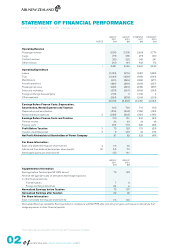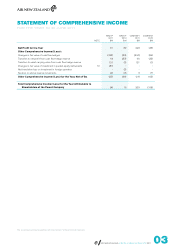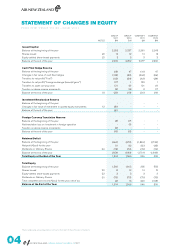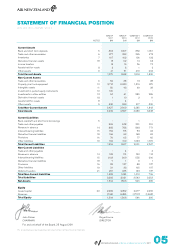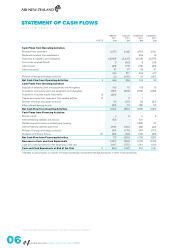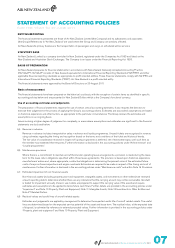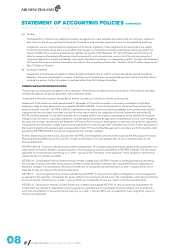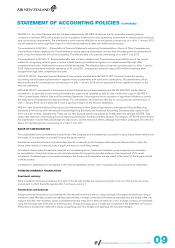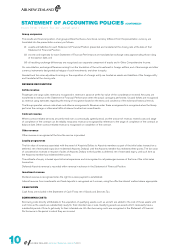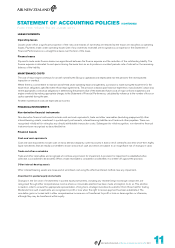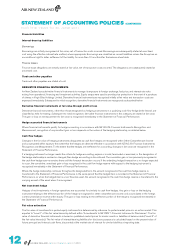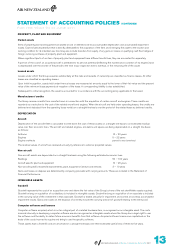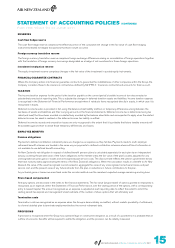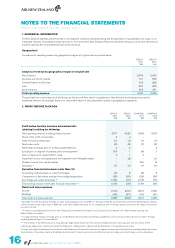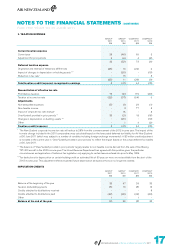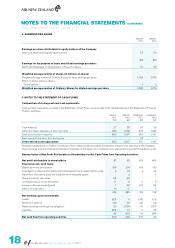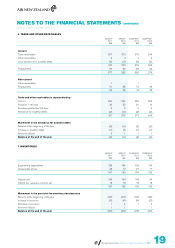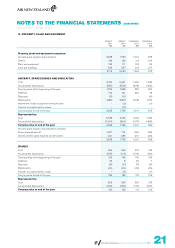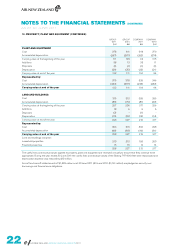Air New Zealand 2011 Annual Report Download - page 14
Download and view the complete annual report
Please find page 14 of the 2011 Air New Zealand annual report below. You can navigate through the pages in the report by either clicking on the pages listed below, or by using the keyword search tool below to find specific information within the annual report.
Financial Liabilities
Interest-bearing liabilities
Borrowings
Borrowings are initially recognised at fair value, net of transaction costs incurred. Borrowings are subsequently stated at amortised
cost using the effective interest rate method, where appropriate. Borrowings are classified as current liabilities unless the Group has an
unconditional right to defer settlement of the liability for more than 12 months after the balance sheet date.
Finance leases
Finance lease obligations are initially stated at fair value, net of transaction costs incurred. The obligations are subsequently stated at
amortised cost.
Trade and other payables
Trade and other payables are stated at cost.
DERIVATIVE FINANCIAL INSTRUMENTS
Air New Zealand uses derivative financial instruments to manage its exposure to foreign exchange, fuel price, and interest rate risks
arising from operational, financing and investment activities. Equity swaps were used to provide price protection in the event of a purchase
of shares in Virgin Blue Holdings Limited. Derivative financial instruments are recognised initially at fair value and transaction costs are
expensed immediately. Subsequent to initial recognition, derivative financial instruments are recognised as described below:
Derivative financial instruments at fair value through profit or loss
Derivative financial instruments, other than those designated as hedging instruments in a qualifying cash flow hedge (refer below), are
classified as held for trading. Subsequent to initial recognition, derivative financial instruments in this category are stated at fair value.
The gain or loss on remeasurement to fair value is recognised immediately in the Statement of Financial Performance.
Hedge accounted financial instruments
Where financial instruments qualify for hedge accounting in accordance with NZ IAS 39: Financial Instruments: Recognition and
Measurement, recognition of any resultant gain or loss depends on the nature of the hedging relationship, as detailed below.
Cash flow hedges
Changes in the fair value of hedging instruments designated as cash flow hedges are recognised within Other Comprehensive Income
and accumulated within equity to the extent that the hedges are deemed effective in accordance with NZ IAS 39: Financial Instruments:
Recognition and Measurement. To the extent that the hedges are ineffective for accounting, changes in fair value are recognised in the
Statement of Financial Performance.
If a hedging instrument no longer meets the criteria for hedge accounting, expires or is sold, terminated or exercised, or the designation of
the hedge relationship is revoked or changed, then hedge accounting is discontinued. The cumulative gain or loss previously recognised in
the cash flow hedge reserve remains there until the forecast transaction occurs. If the underlying hedged transaction is no longer expected
to occur, the cumulative, unrealised gain or loss recognised in the cash flow hedge reserve with respect to the hedging instrument is
recognised immediately in the Statement of Financial Performance.
Where the hedge relationship continues throughout its designated term, the amount recognised in the cash flow hedge reserve is
transferred to the Statement of Financial Performance in the same period that the hedged item is recorded in the Statement of Financial
Performance, or, when the hedged item is a non-financial asset, the amount recognised in the cash flow hedge reserve is transferred to the
carrying amount of the asset when it is recognised.
Net investment hedge
Hedges of net investments in foreign operations are accounted for similarly to cash flow hedges. Any gain or loss on the hedging
instrument relating to the effective portion of the hedge is recognised in other comprehensive income and accumulated in the foreign
currency translation reserve within equity. The gain or loss relating to the ineffective portion of the hedge is recognised immediately in
the Statement of Financial Performance.
Fair value estimation
The fair value of investments in quoted equity instruments is determined by reference to quoted market prices in an active market. This
equates to “Level 1” of the fair value hierarchy defined within “Amendments to NZ IFRS 7: Financial Instruments: Disclosures”. The fair
value of derivative financial instruments is based on published market prices for similar assets or liabilities at balance date (“Level 2” of
the fair value hierarchy). The fair value of interest-bearing liabilities for disclosure purposes is calculated based on the present value of
future principal and interest cash flows, discounted at the market rate of interest for similar liabilities at reporting date.
AIR NEW ZEALAND ANNUAL FINANCIAL RESULTS 2011
STATEMENT OF ACCOUNTING POLICIES (CONTINUED)
FOR THE YEAR TO 30 JUNE 2011


